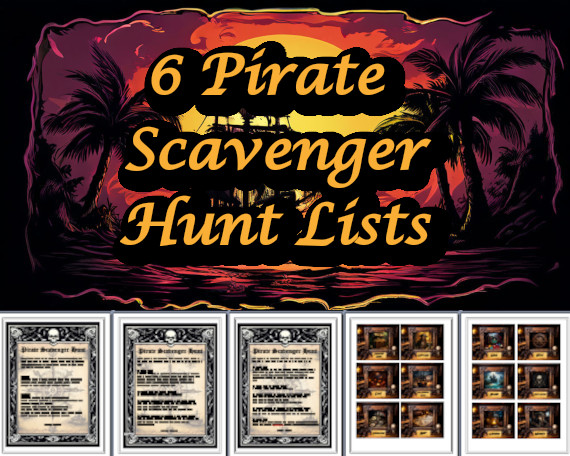
Traffic Control in a Treasure Hunt
Depending on the number
of people participating in your treasure hunt and the size of the playing
area, numerous problems can arise in dealing with the flow of people during
the treasure hunt itself. In this article we'd like to address some of
the potential issues that can come up during a treasure hunt as well as
some things you can do to prepare for them.
~ For larger groups, do what you can to create easy flow in/out at the
different stops. Whenever possible, provide a separate entrance and exit
into the room or space. If not, you'll find congestion when people are
trying to go in and out of the same door or hallway at the same time.
If the treasure hunt is in a race style format, this can be even more
problematic as accidents can happen when participants are squeezing by
each other at a running pace.
 |
6 Pirate Themed Scavenger Hunt Lists - Download them all now! With six different lists to choose from, you won't have any trouble finding the perfect activity you'd like to plan. There's even a for prereaders (with images only.) High quality images are also included that can be printed and hidden so that your scavenger hunt can be set up just about anywhere. Photo hunt options, bonus points and even a couple puzzles thrown in. You'll find the list that's just right for you! CLICK HERE TO DOWNLOAD THEM! |
~ Station volunteers at key points of the treasure hunt who can monitor
the safety of certain situations as well as the integrity of any clues
that you have hidden. If some 'smart' treasure hunter chooses to move
one of your clues in an effort to be cute, you could be facing a large
build up of lost players at a certain stop. Having someone stationed there
will help.
~ Get a good feel for the actual path of the treasure hunt you're creating…especially
if it will be all on foot and there's a lot of walking. Keep in mind that
typically the older the participant, the more leisurely the pace with
which they'll prefer to take on the hunt. Additionally, the younger the
participant, the more that physical activity will be appreciated…but
that also means more space will be needed.
Probably the number one question we've fielded from folks over the years
is how to deal with a linear treasure hunt and the problem of everyone
running to the same stops at the same time. It can create HUGE congestion
at the very beginning and the participants find themselves following the
pack rather than solving any of the puzzles or completing the activities
on the way. Although it can take a lot of experience to create and design
hunts to handle these types of problems, here are some simpler suggestions
that can get you started:
~ Stagger the treasure hunters as they begin the actual hunt. Allow for
a 2-3 minute break in between each team heading for the first clue.
~ Provide an activity or challenge that the teams/participants must complete
before they are given their first clue. Once the task is completed and
is verified by you or another volunteer, the team is given the first clue
and they can head out. This will create a natural staggering of the participants
from the beginning.
~ This solution can be tricky, but once you fully understand the concept
it can be a life saver with larger groups. Create a loop to your treasure
hunt rather than something linear.
By this we mean making sure that the last stop on the treasure hunt will
actually lead them to the first stop. Now, how does this work if it loops
them back? Well, the solution lay in your design and the instructions
you give at the beginning of the hunt to the participants. Explain that
each team/player will be given a different place to start the treasure
hunt. They are to visit every stop along the hunt path (be sure to tell
them how many stops to expect) and when they've finished, they are to
meet at a separate location. With this type of format, you can have them
collect different items from each location, stamps on a card, etc. so
that they can verify that they indeed did stop at each location. This
option can also work well for those teams that get stuck at a certain
point in the hunt…they'll already know where to go at the end and
they can head there in the event of an emergency, etc.